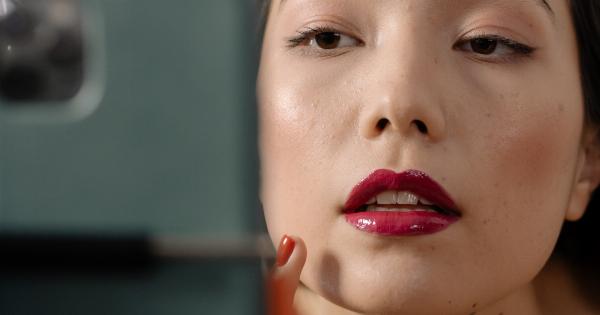Many people underestimate the importance of their lips when it comes to their overall health. We often focus on taking care of our skin, hair, and teeth, but neglect our lips in the process.
However, the condition of your lips can actually provide valuable insights into your general well-being. From dryness and discoloration to sores and odd textures, various lip issues can be indicative of underlying health concerns.
In this article, we will explore the link between your lips and your health, and discuss some common lip conditions and what they may indicate.
1. Pale Lips
If your lips appear paler than usual, it could be a sign of anemia. Anemia is a condition characterized by low levels of red blood cells or hemoglobin in the blood.
This can lead to reduced oxygen delivery to various parts of the body, including the lips, resulting in a paler color. If you notice persistent paleness in your lips, it is recommended to consult with a healthcare professional to determine the underlying cause.
2. Dry and Chapped Lips
Dry and chapped lips are a common issue, especially during colder months. However, persistent dryness and chapping could be a result of underlying health conditions such as dehydration, nutritional deficiencies, or certain medications.
Dry lips can also be associated with breathing through the mouth, which can lead to excess evaporation of moisture from the lips. Using a lip balm or moisturizer regularly and staying hydrated can help alleviate this issue. If dryness persists despite these measures, it is advisable to seek medical attention.
3. Swollen Lips
Swollen lips can be a sign of an allergic reaction. Allergens such as certain foods, medications, or insect bites can trigger an immune response, causing the lips to swell.
If the swelling is accompanied by other symptoms such as difficulty breathing or hives, it may indicate a severe allergic reaction that requires immediate medical attention.
4. Cold Sores
Cold sores, also known as fever blisters, are small, painful blisters that typically appear on or around the lips. They are caused by the herpes simplex virus and are highly contagious.
Cold sores can be triggered by several factors, including stress, sunlight, and weakened immune system. While there is no cure for the herpes virus, antiviral medications can help alleviate symptoms and prevent outbreaks. It is important to avoid sharing personal items such as lip balms or utensils to minimize the risk of spreading the infection.
5. White Spots or Patches
Finding white spots or patches on your lips can be concerning, but they are usually harmless and temporary. These spots can be caused by a variety of factors, including irritation, lip biting, or fungal infections.
However, if the white spots persist, grow larger, or become painful, it is advisable to consult with a healthcare professional to rule out any underlying medical conditions.
6. Red and Inflamed Lips
Red and inflamed lips can indicate an allergic reaction, exposure to irritants, or a skin condition like dermatitis or eczema. Certain vitamin deficiencies (such as a lack of B vitamins) can also cause inflammation and redness of the lips.
It is important to identify and avoid any potential triggers for the inflammation and, if necessary, seek medical advice for appropriate treatment.
7. Cracked or Split Lips
Cracked or split lips, often referred to as cheilitis, can be caused by various factors. Dry weather, dehydration, excessive licking or biting of the lips, and allergic reactions to certain products can all contribute to this condition.
Applying a soothing lip balm with natural ingredients like beeswax or shea butter can help heal and prevent further cracking. However, if the condition persists or becomes painful, it is best to consult with a healthcare professional.
8. Blue or Purple Lips
If your lips have a blue or purple tint, it may indicate a lack of oxygen in the blood or poor circulation.
Conditions like respiratory problems, heart issues, or cold temperatures can restrict blood flow and oxygenation, causing the lips to appear bluish. If you notice persistent discoloration, it is important to consult with a healthcare provider to determine the underlying cause and receive appropriate treatment.
9. Ulcers or Sores
Recurring ulcers or sores on the lips can be a symptom of a condition called recurrent aphthous stomatitis, commonly known as canker sores. These painful sores can be triggered by stress, hormonal changes, nutritional deficiencies, or certain foods.
While they can be managed with over-the-counter or prescription medications, it is recommended to seek professional advice if the ulcers persist or if you experience other concerning symptoms.
10. Thickened or Scaly Lips
If your lips appear thickened or scaly, it could be a sign of a fungal or bacterial infection. It can also be associated with chronic conditions like actinic cheilitis or certain types of skin cancer.
If you notice these symptoms, it is vital to seek medical attention for an accurate diagnosis and appropriate treatment.
Conclusion
Your lips play a significant role in expressing emotions, communicating, and even eating, but they are also indicative of your overall health.
From pale lips suggesting anemia to red and inflamed lips possibly pointing to an allergic reaction, paying attention to any concerning changes in your lips is crucial. It’s essential to remember that while this article provides general information, it is not a substitute for medical advice.
If you have persistent symptoms or any concerns, it is always best to consult with a healthcare professional who can offer guidance specific to your situation.































